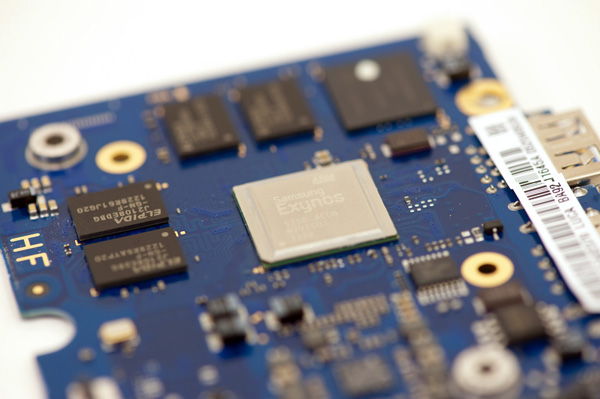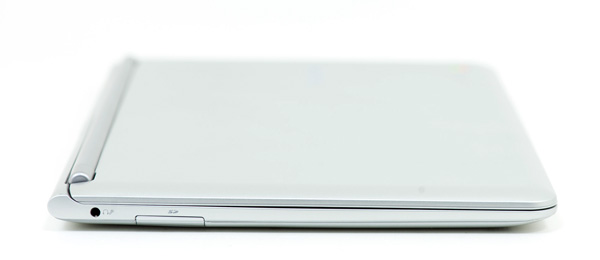Samsung Chromebook (XE303) Review: Testing ARM's Cortex A15
by Anand Lal Shimpi on October 31, 2012 9:00 AM ESTFinal Words
The move to ARM doesn't fundamentally change the performance or usability of the Chromebook. It's still a slow (relative to more expensive notebooks), limited use notebook. That's not necessarily a bad thing, but you need to be aware of what you're getting into with this thing.
The display is functional but not very good. Build quality is decent but the new Chromebook is still a plastic notebook. Thankfully the keyboard and trackpad are both pretty decent.
For a basic web browsing and glorified typewriter platform, the Chromebook really does get the job done. It's a very focused, simple device that serves its purpose well. I don't know how big the Chromebook niche is, but Google has targeted it very well. At $249 if you need a physical keyboard and only need basic web browsing support, I don't know that there's a better solution. As an almost-disposable notebook for writing and browsing the web, I'm happy with the Chromebook. Good ultraportables are much more expensive, and even low cost PCs don't come with any sort of solid state storage. Admittedly the eMMC solution in the Chromebook isn't setting any records, but it does deliver consistent IO performance which is more than I can say for a cheap 5400 RPM 2.5" hard drive.
Ultimately the Chromebook puts pressure on the traditional PC notebook ecosystem from below. Tablets have been doing that for a while but they are a physically different form factor. For those who still want a traditional notebook form factor, there hasn't been much low-cost competition. The Chromebook applies a good amount of pressure there. Compared to a $1000 notebook, the Chromebook's display isn't great but move down into the $500 - $700 range and it doesn't look all that bad thanks to many PC makers failing to invest in good quality panels. If a $249 Chromebook delivers a competitive keyboard, trackpad, display resolution and quality experience to your $499 PC notebook, it's time for a change. With Apple pushing at the top and Google working the bottom, the hope is that the entire PC notebook stack gets better.
On the SoC side, our first look at ARM's Cortex A15 is quite positive from a performance standpoint. I'm still not convinced on its power consumption for smartphone use (big.LITTLE must exist for a reason) but from a performance standpoint, it's going to make current smartphone/tablet SoCs feel very slow. And that's something we can all look forward to in 2013.












149 Comments
View All Comments
extide - Wednesday, October 31, 2012 - link
Yeah, basically this next gen 22nm Atom core is going to be make it of break it for the Atom. I can see the Atom getting canned entirely if the 2nd gen core on 22nm sucks.andrewaggb - Wednesday, October 31, 2012 - link
Yeah, intel must be feeling crazy pressure. They are 6-12 months behind. Both Haswell and the new atom should be coming out now with windows 8.amdwilliam1985 - Wednesday, October 31, 2012 - link
I'm impressed by the ARM performance, besides the performance and battery life, there is also the cost to consider. As far as I know, ARM cpu cost much less than x86 cpu.If I can get 50% of power for 25% of the price, that sounds like a good trade off in many scenarios.
wsw1982 - Thursday, November 1, 2012 - link
The samsung arm a15 is basically a 6+ w SOC... If you linear scale the medfield up 3 times, it means a three core atom, and three times the graphic power (does scale linearly), and i think the performance is comparable. The medfeld is arround 64 mm2, and the three core atom and graphic is, to my best guess, 100mm2, any one give me a estimation of the die size of the samsung a15? we can calculate the price :)krumme - Friday, November 2, 2012 - link
The intereting thing is the total cost for the OEM. The A15 implemented as here must be dirt cheap.Intel have high fixed cost, but arm can spread the cost to phones whatever through both Samsung but primarily TSMC.
In the long run it will be difficult for Intel the have the same low cost.
Years back they could use old fab equipment for the Atom and in that way use production capacity that had been written off the the worst part. Today they they need the new process nodes to be competitive, and that will raise cost for the Atom. I think they are in a bad market here.
Competing with TSMC and Samung is another world from competing with AMD and GF.
They need their ultrabooks, but the market is to small for the future fab cost.
Now arm can share cost from phones to notebooks. That is massive cost advantage imho.
mayankleoboy1 - Wednesday, October 31, 2012 - link
A chromebook is too niche a product to properly judge a SoC . Typically thermals are completely different.Its fast, yes, but how will it do in a smartphone ? And chromeOS has too few apps and the chromebook has too less a res to actually judge the best SoC .....
Krysto - Thursday, November 1, 2012 - link
Not like the Atom one was using bigger resolution. And Exynos 5 Dual can support up to 2560x1600, as we've already seen with Nexus 10.MilwaukeeMike - Wednesday, October 31, 2012 - link
Maybe I missed it, but does this have a built in webcam? Looks like it does from info on other sites, and I'd like to know how it performs for Skype purposes if anyone knows. Sounds like videos from youtube/facebook work ok as well, which would make this a great netbook style option.deneb - Wednesday, October 31, 2012 - link
For that price, why wouldn't anyone get a used laptop instead? At least then they'll get the benefit of a proper OS of their choice (linux or Windows, i don't know if used apple lappies go that low).Granted, it wouldn't be new, but at least it would be many times more functional - no? :)
Midwayman - Wednesday, October 31, 2012 - link
Battery life. A old low end laptop is going to have terrible battery life.